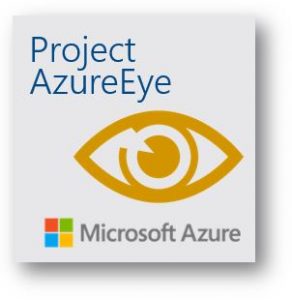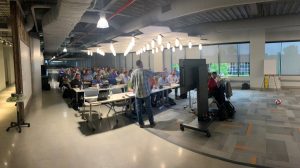 We know that the planned sale of our Orangewood offices that houses one of our key data centers forced us to think creatively and pivot even faster than anticipated to moving our data center to a cloud approach. We know from Open Forums and other information B.J. has shared that we’ll be partnering with Microsoft to utilize their Azure cloud solutions and collaborate with their implementation partners Accenture and Avanade to help us.
We know that the planned sale of our Orangewood offices that houses one of our key data centers forced us to think creatively and pivot even faster than anticipated to moving our data center to a cloud approach. We know from Open Forums and other information B.J. has shared that we’ll be partnering with Microsoft to utilize their Azure cloud solutions and collaborate with their implementation partners Accenture and Avanade to help us.
Now that we are seeing the work underway and hearing about Project Azure Eye, we thought it would be great to chat with Don Waters, VP of IS engineering, about this exciting work.
What apps, data storage, and compute capacity is currently located in the Orangewood data center?
The Orangewood data center supports a broad portfolio of business, clinical, and core infrastructure applications, with a large compliment of associated server, storage, and compute platforms. The current inventory consists of 800 virtual machines, 112 physical servers, roughly 665 terabytes of storage, hosting 237 applications. The assessment and planning of how each of these individual applications and workloads will be migrated is currently underway.
Can you tell us a little bit about Project AzureEye? How did the project get its name?
AzureEye is primarily focused on migrating workloads to the Microsoft Azure cloud. The “eye” part of the name is about always keeping the team’s eye on the target. With the compressed timeline, we must stay focused on the goal and the critical dates. Being a James Bond fan my entire life, and a huge fan of the movie Golden Eye, the name just worked. As we expand to additional facilities, there is enthusiasm to stay loyal to a “Bond theme” when naming additional DC cloud migration projects. There is certainly enough material to draw from!

We’ve seen some photos of working sessions in California with Accenture and Avanade. Tell us a bit about what those were all about and who got to take part?
The second floor at the PSJH Orangewood building in Anaheim is providing the perfect flexible space allowing the AzureEye team participants to gather in a single, pro-collaborative location. Part of the floor space has been organized into a classroom style approach. There are several breakout meeting rooms, and small huddle spaces fostering group brainstorming sessions and whiteboard solutioning. The sessions here have included Azure cloud education, Azure cloud foundational design, and AzureEye application migration planning workshops. Pulling from internal PSJH expertise, the team is represented by caregivers from core IS infrastructure, IS security, IS applications, IS health intelligence, and IS business services all engaged and contributing to the success of the project.
We know that cloud is a huge part of our strategy to simplify and modernize. How is Azure going to allow us to accelerate that transition?
Microsoft Azure provides a holistic suite of integrated services which allows us to migrate our applications with minimal impact, and to establish a cloud operating model using Azure Infrastructure as a Service (IaaS). Utilizing Azure cloud-native tools and services, we can modernize our infrastructure and our capabilities to rapidly scale to the demands of our business. Azure also provides many Platform as a Service (PaaS) cloud-native tools which provide new capabilities for automating our operational workflows as well as a rich set of self-service features. This helps us to consolidate our existing vendor and tools footprint, increasing our efficiency and capacity to support the business.
Does this involve SaaS and support building our strategy and capacity around that?
While SaaS (Software as a Service) is an important part of our business strategy, the scope of the AzureEye project currently does not involve SaaS. There are many Azure PaaS (Platform as a Service) services similar to SaaS being configured to help PSJH manage the environment and utilizing modern, streamlined tooling to ensure operational success and protection of our data. Some examples are: managed Database as a Service (e.g. Azure SQL, Azure Cosmos DB), Monitoring as a Service (e.g. Azure Monitor, Log Analytics), and Security as a Service (e.g. Azure Security Center, Key Vault, Web Application Firewall, etc.). In the legacy model, these would typically represent separate products, separate vendors, and separate support contracts.
I know that Orangewood cloud transition with Azure is a test bed and pilot for how we’ll approach transitioning some of our other data centers. What are some early findings that we can apply to our overall transition to embracing the cloud and having less physical data center space?
Initially, we went into the project with some pre-conceived notions regarding application platform incompatibility for Azure. With some guidance provided by Microsoft, Accenture, and Avanade we were able to work through the application architecture process and identify larger populations of applications that were Azure cloud capable. Additionally, although we are focused on the Azure cloud, we have learned that cloud is not a location or place, it is an operating model. We are learning how to transform our services and our caregivers towards modernized cloud operational workflows. Learning the art of the possible by removing barriers and constraints that used to slow our ability to delivery on demand.
What timeline do we have for that work expanding to our other data centers?
As AzureEye for Orangewood is well underway, the work to assess and inventory our Alaska, Burbank, and Lubbock data centers has already begun. The project planning phase for Alaska will begin in early August of 2019, with a 6-9 month proposed completion timeframe. As teams become more familiar and comfortable with the processes, we expect an acceleration of work and parallel timeframes for Burbank and Lubbock potentially beginning in March/April of 2020.
What excites you most about partnering with Microsoft and Accenture/Avanade?
It has been exciting to work with Microsoft, Accenture, and Avanade and leverage their multi-industry, global scale experience. From the AzureEye work, we have thrown a variety of challenges to their teams and it’s been awesome having them bring in different sets of experts to solve different sets of problems all in the spirit of making our project successful. Their support and commitment level have been outstanding!
What growth, educational, and development opportunities does this offer our caregivers?
In addition to participating in many AzureEye workshops, all-day design sessions, and subject matter-specific training, all IS caregivers are going to have the opportunity to learn about cloud fundamentals and Microsoft Azure.
We’re sharing an exciting program we’ve developed with Microsoft Learning. It’s called the IS Cloud Skills Challenge and offers to those interested, an opportunity to complete a variety of online training modules on cloud basics, Azure fundamentals, and advanced Azure services. Completing the modules can win you points that can be redeemed for some fun prizes, including a Microsoft Surface, tee shirts, and more. Participants can monitor the leaders board to inspire some healthy competition! We’re going all in on Azure and having fun while leveling up our skills in a “game-ified” training challenge will be a great opportunity.
More information
Check out the IS Cloud Skills Challenge and consider signing up.
Check out the Project AzureEye Yammer group.
Please contact Don Waters, VP of IS Engineering, with questions.
